| dc.contributor.author | Guo, Zhiwei | |
| dc.contributor.author | Tang, Lianggui | |
| dc.contributor.author | Guo, Tan | |
| dc.contributor.author | Yu, Keping | |
| dc.contributor.author | Alazab, Mamoun | |
| dc.contributor.author | Shalaginov, Andrii | |
| dc.date.accessioned | 2022-11-16T10:17:51Z | |
| dc.date.available | 2022-11-16T10:17:51Z | |
| dc.date.created | 2021-11-25T14:21:55Z | |
| dc.date.issued | 2021 | |
| dc.identifier.citation | Future generations computer systems. 2021, 117 205-218. | en_US |
| dc.identifier.issn | 0167-739X | |
| dc.identifier.uri | https://hdl.handle.net/11250/3032114 | |
| dc.description.abstract | Due to the severe threat to cyberspace security, detection of online spammers has been a universal concern of academia. Nowadays, prevailing literature of this field almost leveraged various relations to enhance feature spaces. However, they majorly focused stable or visible relations, yet neglected the existence of those which are generated occasionally. Exactly, some latent feature components can be extracted from the view of heterogeneous information networks. Thus, this paper proposes a Deep Graph neural network-based Spammer detection (DeG-Spam) model under the perspective of heterogeneous cyberspace. Specifically, representations for occasional relations and inherent relations are separately modelled. Based on this, a graph neural network framework is formulated to generate feature expressions for the social graph. With more feature components being mined, acquirement of stronger and more comprehensive feature spaces ensures the accuracy of spammer detection. At last, fruitful experiments are carried out on two benchmark datasets to compare the DeG-Spam with typical spammer detection approaches. Experimental results show that it performs about 5%–10% better than baselines. | en_US |
| dc.language.iso | eng | en_US |
| dc.publisher | Elsevier | en_US |
| dc.rights | Attribution-NonCommercial-NoDerivatives 4.0 Internasjonal | * |
| dc.rights.uri | http://creativecommons.org/licenses/by-nc-nd/4.0/deed.no | * |
| dc.title | Deep Graph neural network-based spammer detection under the perspective of heterogeneous cyberspace | en_US |
| dc.type | Peer reviewed | en_US |
| dc.type | Journal article | en_US |
| dc.description.version | acceptedVersion | en_US |
| dc.source.pagenumber | 205-218 | en_US |
| dc.source.volume | 117 | en_US |
| dc.source.journal | Future generations computer systems | en_US |
| dc.identifier.doi | 10.1016/j.future.2020.11.028 | |
| dc.identifier.cristin | 1959120 | |
| cristin.ispublished | true | |
| cristin.fulltext | postprint | |
| cristin.qualitycode | 2 | |

